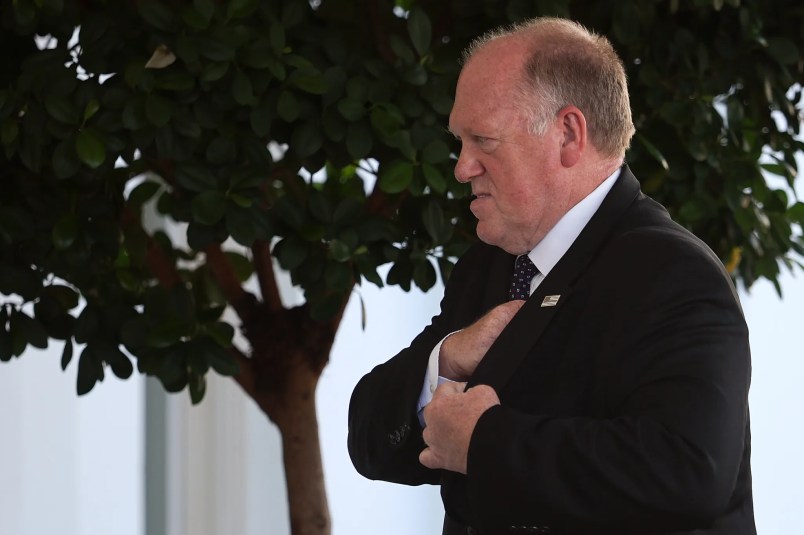This article is part of TPM Cafe, TPM’s home for opinion and news analysis. It was originally published at Balls and Strikes.
In a sting operation last September, White House “border czar” Tom Homan accepted $50,000 cash in a bag from Cava, the fast casual Mediterranean restaurant chain, from undercover FBI agents whom he believed to be business executives in want of an inside track for government contracts, according to reporting from MSNBC. Homan served as Acting Director of Immigration and Customs Enforcement during President Donald Trump’s first term, and at the time of the FBI investigation, he was widely expected to resume oversight of federal immigration policy should Trump reenter office.
Agents, who recorded the entire transaction, had planned to keep monitoring Homan to see if he got the role and followed through on his pay-for-play promise, but now that he’s in position to hold up his end of the bargain, Trump appointees at the FBI and the Department of Justice have squashed the investigation. In a statement provided to MSNBC, FBI Director Kash Patel and Deputy Attorney General Todd Blanche claimed that their staff reviewed the matter that “originated under the previous administration” and determined there was “no credible evidence of any criminal wrongdoing.”
The existence of non-criminal reasons for accepting $50,000 in a pita pocket probably comes as a surprise to most normal people. But the Supreme Court is famously fond of bribery, and has made it increasingly difficult to successfully prosecute public corruption. In doing so, the Court has made it increasingly easy for people like Homan to take their alleged bribes to-go.
Since 2016, the Court has overturned federal public corruption convictions at least three times. First, the Court came to the aid of former Virginia governor Bob McDonnell, who accepted over $175,000 in gifts and loans from a pharmaceutical company in exchange for hooking the business up with free product testing at the state’s public universities. Taking “official action” in exchange for money (or anything else of value) is a felony under federal bribery statutes. But in McDonnell v. United States, the Court said there was no official action here, recasting the phone calls McConnell placed and meetings he organized on the company’s behalf as innocent constituent services. “Setting up a meeting, calling another public official, or hosting an event does not, standing alone, qualify as an official act,” wrote Chief Justice John Roberts for the unanimous Court.
Next, in 2020, the Court helped out the two former aides to New Jersey Gov. Chris Christie who masterminded “Bridgegate.” The busiest bridge in the world runs between Manhattan and Fort Lee, New Jersey, and the mayor of Fort Lee did not endorse Christie’s reelection campaign. So, without warning, the aides reduced the bridge’s three lanes to just one, creating a spite-fueled traffic nightmare. In an attempt to cover up their retaliatory scheme, the aides pretended they were conducting a traffic study and directed Port Authority engineers to collect pointless data.
Defrauding federally funded organizations, like the Port Authority, is a federal crime. But in Kelly v. United States, the Court again unanimously reversed the aides’ convictions. Because the “object of the fraud” was not money or property, Justice Elena Kagan wrote, this wasn’t a crime, it was just a dick move.
Finally, in 2024, the Court saved James Snyder, the former mayor of Portage, Indiana, who asked a company to pay off his tax debt and contribute to his vacation fund after he awarded the business a lucrative city contract. He was convicted under bribery statutes that make it a crime for officials to “corruptly” solicit or accept “anything of value” while “intending to be influenced or rewarded.”
Again, if you’re a normal person, this case seems pretty clear-cut. But in Snyder v. United States, six justices worked hard to find some ambiguity: According to Justice Brett Kavanaugh, bribes are “payments made or agreed to before an official act in order to influence the official with respect to that future official act.” But “a token of appreciation” after the fact is just a “gratuity,” which is, in the Court’s estimation, legally A-okay.
Perhaps as a nod to the Court’s permissive treatment of public corruption, officials in Trump’s Justice Department told the New York Times that they doubted they could make Homan’s case in front of a jury: They did not have proof that Homan had agreed to do any specific acts for money, they claimed, and Homan was not a public official at the time. For this reason, the Times speculated that the Homan investigation might “have been dropped regardless of which party controlled the White House”: Even if the Trump Department of Justice didn’t drop the case in order to protect Homan—a big if—the Court has created a legal landscape that often makes prosecutors in bribery cases confused about whether they’re on solid ground.
The Court’s lax attitude toward public corruption law has left federal law ill-equipped to respond to the realities of how corruption works—leaving officials free to keep their hands out and takeout bags open, ready to take advantage.





